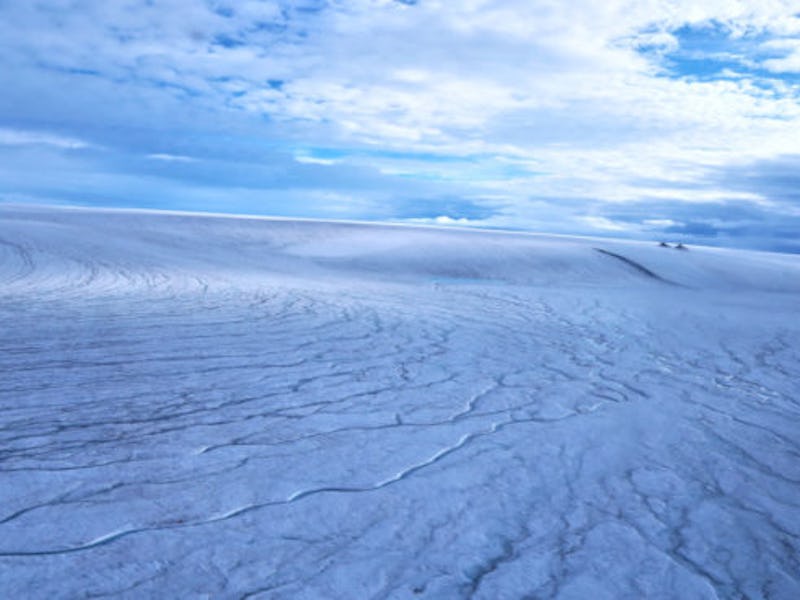Water on Mars? A new study challenges a common idea in compelling style
Scientists believe the planet may now have had a better chance of supporting life.

For decades, astronomers have wondered about Mars' past. Did the now dry, desolate world once support a form of life, and were the planet's conditions at one point habitable?
Mounting evidence has suggested that the Red Planet was warm and wet during its early history, about 4 billion years ago. However, a new study challenges this theory, and instead suggests that valleys of water may have formed beneath ice sheets covering the Martian surface.
The study, published Monday in the journal Nature Geoscience, may dispute a long-standing theory about Mars but it also suggests that the Red Planet now has a higher chance of hosting life beneath its icy surface.
Could Mars have hosted life beneath icy glaciers covering its surface?
The surface of Mars is scarred by hundreds of massive valleys. Some of the valleys stretch across 5,000 kilometers long, the distance between Paris to New York, according to the European Space Agency.
“For the last 40 years, since Mars’s valleys were first discovered, the assumption was that rivers once flowed on Mars, eroding and forming all of these valleys,” Anna Grau Galofre, geophysicist and a former Ph.D. student at the University of British Columbia's Department of Earth, Ocean and Atmospheric Sciences, and lead author of the study, said in a statement.
The team of researchers behind the new study analyzed the valleys on Mars using a computer algorithm, looking at their morphology or how they formed. They found that the majority of these valleys did not form as a result of water flowing rivers, but instead from water melting beneath ice glaciers that covered the surface of Mars.
The team also compared the valleys on Mars to a similar terrain here on Earth.
Devon Island in the Canadian Arctic often serves as an analogue to the Martian environment as it is also marked by valleys and subglacial channels.
“Devon Island is one of the best analogues we have for Mars here on Earth,” Gordon Osinski, director of Western University's Institute for Earth and Space Exploration, and co-author of the study, said in a statement. “It is a cold, dry polar desert and we know the glaciation is largely cold-based.”
According to the study, the valleys on Mars and the ones that had formed on Devon Island showed a lot of similarities. By comparing valleys that the researchers believe had formed beneath ice on Mars to ones that had formed on Earth through a similar process, the study suggests that the majority of the Martian valleys were a result of ice glaciers.
"If you look at Earth from a satellite you see a lot of valleys: some of them made by rivers, some made by glaciers, some made by other processes, and each type has a distinctive shape," Grau Galofre said. "Mars is similar, in that valleys look very different from each other, suggesting that many processes were at play to carve them.”
The study also helps explain how these valleys formed nearly 4 billion years ago when the Martian climate was much cooler than it is today considering that the Sun was cooler during its early history, and therefore would have emitted less heat on Mars.
Although scientists have relied on Mars being warm and wet to it potentially hosting life, this study does not exactly negate the planet's past habitability. Instead, the researchers suggest that life had a higher chance of survival if Mars did in fact have ice glaciers.
Ancient Martian life would have survived better in the water trapped beneath the sheets of ice, protected from the radiation of the Sun.
Abstract: The southern highlands of Mars are dissected by hundreds of valley networks, which are evidence that water once sculpted the surface. Characterizing the mechanisms of valley incision may constrain early Mars climate and the search for ancient life. Previous interpretations of the geological record require precipitation and surface water runoff to form the valley networks, in contradiction with climate simulations that predict a cold, icy ancient Mars. Here we present a global comparative study of valley network morphometry, using a principal-component-based analysis with physical models of fluvial, groundwater sapping and glacial and subglacial erosion. We found that valley formation involved all these processes, but that subglacial and fluvial erosion are the predominant mechanisms. This is supported by predictions from models of steady-state erosion and geomorphological comparisons to terrestrial analogues. The inference of subglacial channels among the valley networks supports the presence of ice sheets that covered the southern highlands during the time of valley network emplacement.